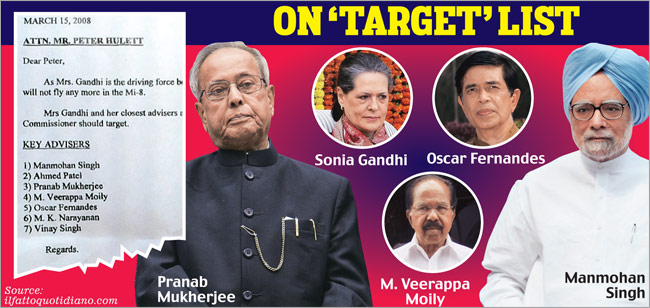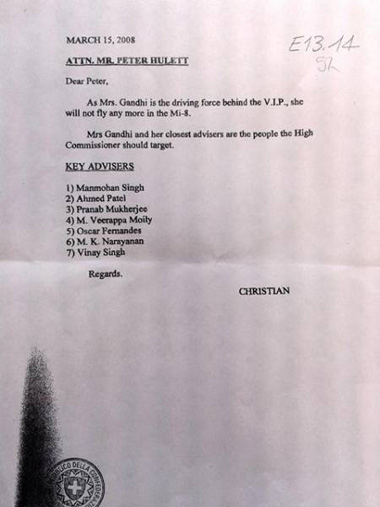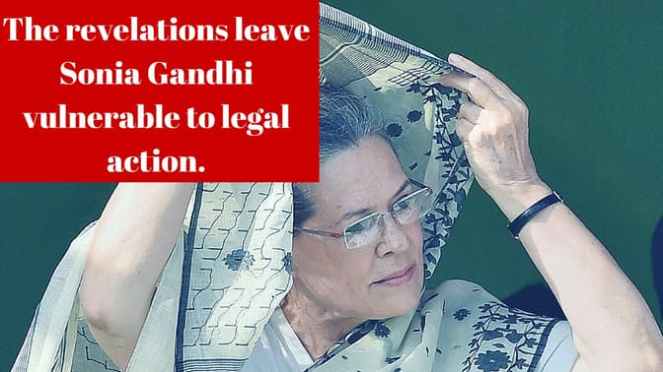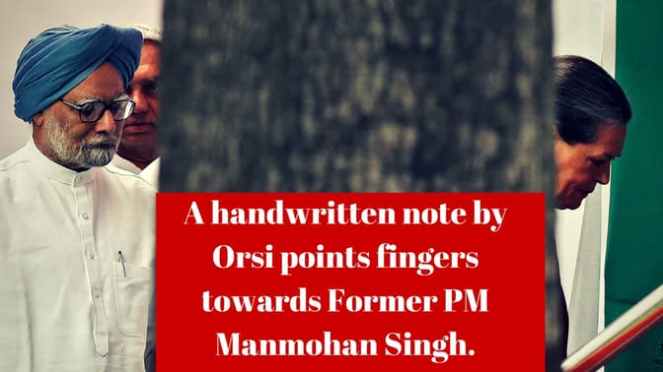Story of the ₹36 billion deal for 12 AW-101 choppers to ferry VVIPs that ran into rough weather when it was discovered that bribes were paid to IAF officers, bureaucrats and politicians in India to win the deal.
Current Status:
- In April 2016, Guiseppe Orsi, the former chief of Finmeccanica UK (which owns AgustaWestland) and Bruno Spagnolin, who headed chopper division AgustaWestland were sentenced to four-and-a-half years and four years imprisonment respectively. The court also ordered the two executives to pay €7.5 million euros ($8.5 million). The two officials were held guilty of paying bribes to Indian officials.
- UPA government did not blacklist AgustaWestland despite allegations of bribery but this was done by NDA in June 2014 when it came to power.
- On July 3, 2014, Arun Jaitley as defence minister issued an order which put on hold all procurement and acquisition cases in the pipeline with six companies involved in the scam including AgustaWestland and Finmeccanica.
- A CBI probe into the matter is ongoing in India.
- London-based consultant Christian Michel (one of the middlemen) is currently on the run, and there’s an Interpol ‘red corner’ notice against him following India’s moves to arrest him in the case. The Milan court had noted that Michel was paid over 44 million euros by AgustaWestland for various contracts, which included a deal to supply spare parts for Indian naval helicopters and a post-contract service deal for the VVIP chopper contract. It also important to note that Michel was paid over ₹ 500 Million to ‘manage’ media.
- The Enforcement Directorate has been pursuing the case too, with Michel’s business dealings in India being probed. The ED, in September 2015 attached assets worth about ₹7 crore alleged to be in the name of cousins of the former IAF chief.
- On Thursday 28th April 2016 the Supreme Court of India said that it would hear a PIL, which seeks to file an FIR against Sonia Gandhi (President of Indian National Congress party) and Manmohan Singh (previous Prime Minister and MP of Indian National Congress party) in the AgustaWestland chopper case.
Who were the middlemen?
The middlemen involved in the deal are Guido Ralph Haschke, his partner Carlos Gerosa and London-based consultant Christian Michel.
Who were paid the bribe?

Italian court finds that the middlemen had agreed for a 7.5% commission/graft to IAF officer and politicians in the deal.
The middlemen involved in the deal Guido Ralph Haschke, his partner Carlos Gerosa and London-based consultant Christian Michel were paid kickbacks totalling € (around ₹4 billion) in the ₹36 billion deal for 12 VVIP helicopters inked with AgustaWestland, the UK-based subsidiary of Italian conglomerate Finmeccanica, in February 2010.
The Central Bureau of Investigation’s First Information Report says: ‘Guido Haschke and Carlo Gerosa managed to send €5.6 million (over ₹470 million) through the Mohali-based IDS Infotech and Chandigarh-based Aeromatrix Info Solutions Private Limited to India and kept the remaining amount of about €24.30 million (around ₹2.05 billion) received from AgustaWestland with themselves in the account of IDS Tunisia.’
Haschke had earlier claimed that €6 million (over ₹510 million) were paid to IAF officers and €8.4 million (around ₹710 million) to bureaucrats, with politicians also getting a cut in the AgustaWestland deal.
Italian prosecutors have claimed that money was paid to close associates, his family – including three cousins of former Indian Air Force chief SP Tyagi. Prosecutors have also alleged that another part of the bribe money was paid through UK-based consultant Christian Michel to political entities in India, and speculated that senior leaders of the then ruling party, Congress, were among the recipients.
The Milan Court of Appeals in Italy, in its judgment, took note of the conversations between the three middlemen — Carlos Gerosa, Christian Michel and Guildo Haschke — who mention ‘Mrs Gandhi’ as being the ‘driving force behind the VIP’ and her close aides Ahmed Patel and Pranab Mukherjee — the latter is referred to as being the ‘British High Commissioner’.
In a letter dated 15 March, 2008, Christian Michel wrote to Peter Hulet, the then head of India region sales and liaison for AgustaWestland, saying “Dear Peter, since Mrs Gandhi is the driving force behind the VIP, she will no longer fly with MI8 … Mrs Gandhi and her closest advisers are the aim of the High Commissioner, senior adviser Prime Minister Manmohan Singh obviously the main figure, then there’s Ahmed Patel Secretary”. One particular note from a middleman reportedly described Gandhi as the “driving force” behind the deal.

What is more embarrassing here for Sonia Gandhi is that the observations made in the judgement:
- The UPA government (of which she was the power behind the throne) showed “substantial disregard to arrive at a full explanation of facts (was) effectively demonstrated by the procedural behaviour of the Indian Ministry of Defence.” In other words, the MoD was less than cooperative in investigating the scandal. It took one full year for the MoD to send three documents to the Italian court.
- Tthe judgement notes the letter written by one of the middlemen Christian Michel to the India head of AgustaWestland, Peter Hulet, which says, “since Mrs Gandhi is the driving force behind the VIP, she will no longer fly with Mi8 …” This is deeply embarrassing but cannot be cited as explicit proof of her involvement. Since she held no government position, she was anyway not entitled to fly by VIP aircraft. But the revelations undermine her politically and could leave her vulnerable to legal action.


What is AgustaWestland VVIP chopper scam?
- In February 2010, the ruling UPA government signed a contract to purchase 12 AgustaWestland AW101 helicopters for Indian Air Force for ₹3600-crore, to carry the president, PM and other VVIPs.
- In February 2013, UPA government decided to put on hold the deal following the arrest of chairman of Finmeccanica Giuseppe Orsi and CEO of Agusta Westland Bruno Spagnolini on 12th February 2013 on the charges that they bribed middlemen to secure the deal with IAF. In March 2013 then defence minister AK Antony had said that corruption had taken places in the purchase of VVIP choppers and that bribes had been taken.
- In 2014, the Congress-led UPA government cancelled the VVIP chopper deal with AgustaWestland on grounds that the integrity pact was violated.
- The government has recovered most of the money paid to the Italian company for the contract.
Detailed history:
- August 1999: IAF highlighted the need of suitable and modern replacement to Defence ministry & PMO for Mi-8 VIP helicopter fleet as they were completing their total technical life. Also, they were unable to operate safely at night and in places with elevation beyond 2000 meters. IAF made a strong plea for a high altitude flying helicopter for areas like Siachen and the Tiger Hill.
- A Request For the Proposal, RFP, was floated. Six companies responded. One of the key requirements in that RFP was that the competing helicopters must be able to fly at altitudes around 6,000 metres (around 19,685 feet) with a full load. After trials, only one helicopter- the Eurocopter’s EC 225 was able to fly at that altitude. Agusta Westland’s A-101 failed to make the list after flight evaluation because it could not fly at 18, 000 feet and above.
- In 2003, the IAF sent its evaluation report to the PMO. Brajesh Mishra, then national security adviser and principal secretary to then prime minister Atal Bihari Vajpayee, asked the Special Protection Group that guards India’s VVIPs, for its comments.
- The SPG apparently said the EC-225 was unsuitable because its cabin height was too short (at 1.39 metres) and that neither the VIPs nor the SPG personnel would be able to stand upright inside such a cabin.
- Mishra then wrote to Air Chief Marshal S Krishnaswamy who had taken over from ACM Tipnis in 2001, expressing concern on two points: A single vendor situation had arisen because of the specification that said the helicopters must be able to fly at altitudes around 6,000 metres and that the SPG’s inputs were not taken. Mishra’s point was that the competition must be broadened and the SPG’s requirements must be met.
- Hence in 2003 the IAF, in consultation with the SPG, drew up the entire Air Staff Qualitative Requirement once again. The new specifications said the helicopters must be able to fly at an altitude of 4,500 metres and that its cabin must be at least 1.80 m in height.
- Meanwhile, Air Marshal S P Tyagi took over as IAF chief in 2004. It took Air Headquarters and the defence ministry’s acquisition wing another three years to issue a fresh Request For the Proposal. That was in 2006. By then Vajpayee’s NDA government had been ousted, and the UPA was in power.
- The new RFP, which went by the specifications finalised in 2003, was issued to six different vendors when Pranab Mukherjee, now India’s President, was the defence minister. Three companies: the makers of Mi-172, Sikorsky which made the S-92 helicopters and AgustaWestland’s AWA101 responded to the RFP.
- Meanwhile, the defence ministry put in place a new concept: the Defence Procurement Procedure. Under this, all companies that bid for contracts above Rs 1 billion have to sign an integrity pact that binds the companies to give an undertaking that no bribes would be paid or that agents would be used in the contracts. The Russian company that manufacturers the Mi-172 withdrew from the competition at an early stage refusing to sign the integrity contract! That left AgustaWestland and Sikorsky in the race. By now this was late 2007.
- Fali H Major, himself a helicopter pilot, had meanwhile taken over as the IAF chief. The evaluations and trials of the S-92 and AW101 began and continued over the next couple of years (2008-2009). According to IAF sources, the S-92 was found to be non-compliant on four counts:
- It could not reach 15,000 feet without maximum power.
- Its ‘hover out off ground effect’ was insufficient.
- Its drift down altitude did not meet the requirement.
- Its missile airborne warning system was not up to the mark.
Whereas AgustaWestland chopper, with its three engines, was a bonus, according to IAF test pilots since one engine failure still meant it had two engines to fall back upon.
- Sometime in 2009, Air HQ sent its recommendation to the defence ministry and after going through stringent financial and technical requirements mandatory under the DPP, a contract was signed in February 2010. By this time, Air Chief Marshal P V Naik was the air chief.
- The first of the AW 101 AgustaWestland helicopters arrived in India in late 2012. Two more helicopters followed in quick succession.
- When a controversy over the deal emerged in 2013 with the arrest of Agusta’s parent organisation Finmeccanica CEO Giuseppe Orsi by Italian authorities, the then United Progressive Alliance government cancelled the deal, recovered the advance paid to the chopper manufacturer and instituted a probe against the alleged middlemen and beneficiaries
- CBI, in a report on its investigation, said the IAF had been “opposing vehemently” any suggestion of lowering the altitude requirement before SP Tyagi became the IAF chief. After Tyagi took over, the “Air Force conceded to reduce” the height requirement, allowing AgustaWestland to re-enter the bidding process, the CBI said.
- In March of 2013, CBI said that it had found evidence against former Indian Air Force chief S P Tyagi that suggested that he had extended favours to the UK-based AgustaWestland by changing specification requirements for the VVIP choppers. The agency registered a first information report (FIR) against Tyagi and 12 others. In its FIR, the CBI also included two top IDS officials — CEO Satish Bagrodia (brother of former Union minister Santosh Bagrodia), and MD Pratap Agarwal — who had not been named in its preliminary inquiry. Days later, the CBI issued lookout notices for Tyagi, his three cousins and five others, named in its FIR.
Read more at: